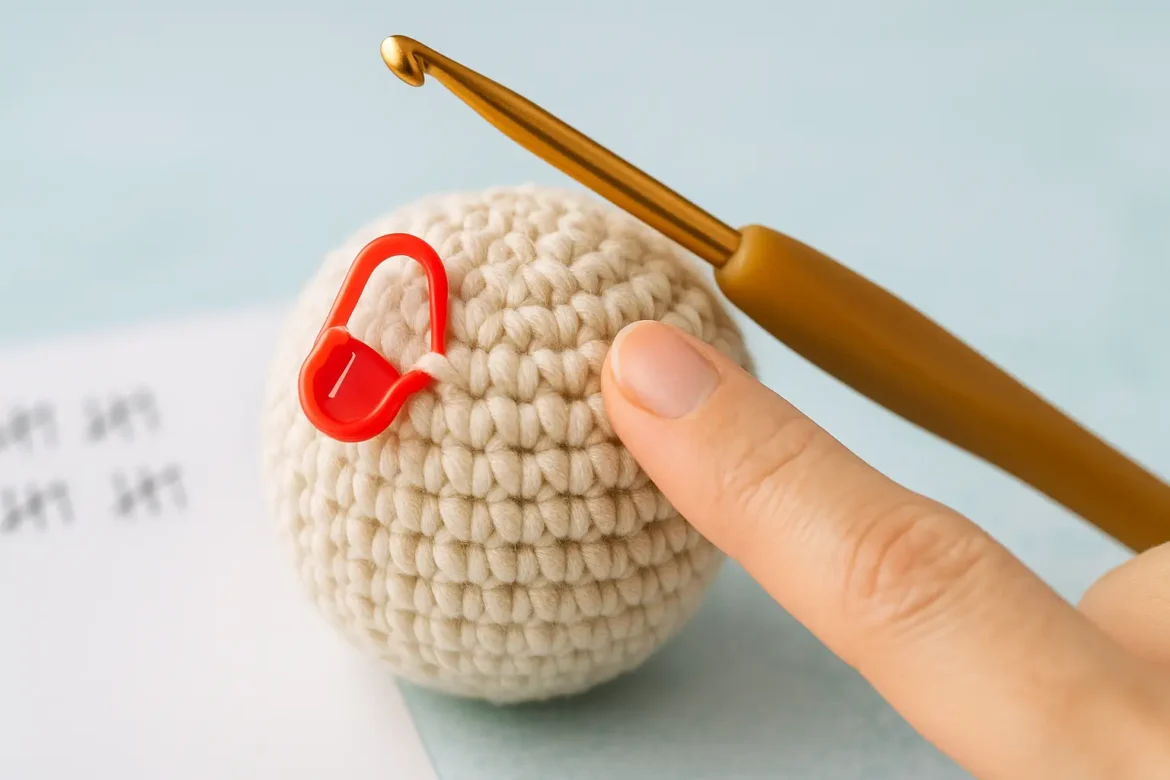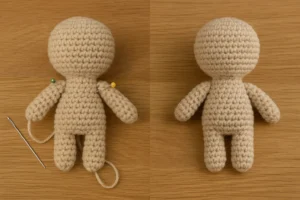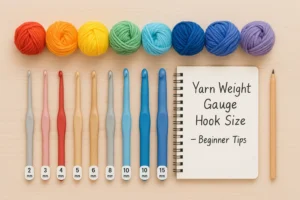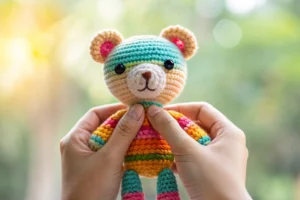Ever pause mid-project wondering, “Did I finish Round 14 or 15?” You’re not alone. Learning how to count rounds in crochet (and how to count crochet stitches in the round) keeps pairs the same length, lines up increases/decreases, and prevents lopsided toys, especially in amigurumi worked in spiral rounds.
In this beginner-friendly guide, you’ll get seven clear methods, from a simple stitch-marker ladder to apps and counters, plus quick fixes for color changes and drifting seams. If you’re brand new, warm up with First Amigurumi – Step-by-Step Guide, compare Magic Ring vs. Chain Circle, and review Yarn Weight, Gauge & Hook Size. For general stitch standards and abbreviations, see the Craft Yarn Council standards and a quick primer on crochet basics and slip stitch joins.
Ready to see how to count rounds in crochet without guesswork? We’ll start with the fastest method that needs zero math, and doubles as your built-in crochet round counter.
Jump to section
Method 1 : Stitch-Marker Ladder (fastest)
When to use: Spiral rounds (amigurumi arms, legs, bodies).
Goal: Always know which round you’re on, no math, no guesswork. This is the simplest way to learn how to count rounds in crochet while you work.
How it works
- Work Round 1 (e.g., 6 sc in magic ring).
- Place a locking stitch marker in the first stitch of the round.
- Finish the round.
- Start the next round and move the marker up to the new first stitch.
- Repeat every round. The marker creates a visible “ladder” of first stitches, an easy visual for anyone asking how to count rounds in crochet.
How to count rounds in crochet with this method
- Follow one vertical stack of “V” stitches from the magic ring center up to the current edge.
- The number of full “V” stacks you pass = completed rounds.
- Your marker shows you exactly where each round began, so you won’t double-count the partial round you’re in. It’s a foolproof crochet round counter you already own.
Why it works
- In spiral rounds there’s no join and no chain; the first stitch is the only reliable landmark.
- Moving the marker each round = a built-in crochet round counter, perfect if you’re still mastering how to count crochet rounds.
Pro tips
- Use two markers: Marker A for the first stitch; Marker B every 5th round (R5, R10, R15). That gives quick checkpoints for long bodies.
- If a marker falls out, locate the tail at Round 1 and recount a single V column to re-anchor your place.
- Soft plastic locking markers are best; in a pinch, a bobby pin or scrap yarn loop works.
Common mistakes to avoid
- Placing the marker in the last stitch, this shifts each round by one and causes seam drift. Always mark the first stitch.
- Forgetting to move it up, if you miss a move, count your V-column to the last moved position, then resume.
- Counting the current half-done round, only count completed rounds.
Method 2 : Count the “V” Stacks (no tools needed)
When to use: Anytime, works for spiral rounds and joined rounds.
Goal: Learn to read your fabric so you can count rounds in crochet even without a marker. This is the purest form of how to count rounds in crochet using your eyes only.
How it works
- Hold the piece with the right side facing you (the neat “V”s on top).
- Find the center of the magic ring (or Round 1).
- Choose one straight vertical column of stitches above that center.
- Count the number of full top “V”s stacked in that column → that equals completed rounds.
Tips for accuracy
- Keep your eye on one column only, don’t drift diagonally.
- If the fabric curves (e.g., a sphere), gently squash it flat to see the column.
- In joined rounds, ignore the slip-stitch join and the turning chain; they’re not “V”s (learn about slip stitches).
- Mid-round? Only count the fully formed V’s below your working loop.
Why it works
Each finished round adds one full layer of V’s. A single column is a timeline: ring center = Round 1, and every V above = the next round.
Quick cross-check (avoid miscounting)
- Compare your count with the expected stitch math (e.g., R4 in amigurumi usually has 24 sts).
- If your number doesn’t match, recount the column or switch to Method 1’s marker ladder to confirm.
Common pitfalls
- Counting the running loop on your hook as a V → it’s not.
- Including the join seam (joined rounds) → skip the slip stitch and starting chain unless the pattern says they count as a stitch.
- Choosing a wobbly column on highly curved parts → pick the most vertical path from the ring.
Method 3 : Tail-as-Compass (built-in Round-1 landmark)
When to use: Great backup for spiral rounds and tiny parts (arms, muzzles) when markers go missing.
Goal: Use your starting tail as a fixed pointer to Round 1 so you can recount anytime, ideal if you’re still practicing how to count crochet rounds with confidence.
How it works
- Leave a short starting tail inside the piece (don’t trim it off early).
- When you’re unsure, insert your hook or a tapestry needle from the edge straight down toward the tail.
- Count the number of full “V” layers you pass from the edge to the tail’s level → that equals completed rounds.
- Resume crocheting; the tail stays as your permanent origin marker.
Pro tips
- If the tail wanders, tug it gently so it sits flat at Round 1.
- For extra clarity, tie a tiny contrasting scrap to the tail, easy to spot through stuffing.
- On two matching parts (e.g., legs), keep the tails the same orientation (both inside-left) so counting is consistent.
Common mistakes
- Cutting the tail too short to see or grab. Leave ~8–10 cm (3–4″).
- Counting diagonally toward the tail, drop a straight line; avoid drifting columns.
- Confusing the tail knot with an extra round, remember, the knot sits within Round 1, not above it.
Method 4 : Hash-Marks on Paper (perfect for TV time)
When to use: Long, even rounds (e.g., “R5–20 sc around”), binge-watch sessions, or when you keep forgetting to move a marker.
Goal: Offload memory—count rounds in crochet with a simple tally so your hands never pause. Many beginners who ask how to count rounds in crochet find this paper trick keeps them on track.
How it works
- Keep a scrap paper (or notes app).
- After finishing each round, add a tally:
||||then cross the fifth like||||\. - Label blocks by range (e.g., “Body R5–20”).
- Compare your tally count to the pattern before starting the next section.
Mini template you can copy
Head — Spiral R1–12
R1–6 : ||||\ || (7) ← stop at 7? frog/finish to the right number
R7–12 : ||||\ | (6)
Total : 13 rounds
Notes : switch to pink yarn at R10; safety eyes between R8–9
Pro tips
- Use two lines: top line = rounds done, bottom line = planned rounds. Cross off the plan as you work.
- Circle every 5th tally (or mark R10, R20…) to create visual checkpoints.
- Pair with Method 1 (marker ladder) so your paper and fabric agree.
Common mistakes
- Ticking mid-round. Only add a tally when the round is fully complete.
- Losing place after a pause. Before breaks, write “Next: R14” so you restart confidently.
- No labels. Always note the section name (Head/Leg), range (R5–20), and any color changes.
Method 5 : Digital & Physical Round Counters (hands-free accuracy)
When to use: Long bodies, repetitive “sc around” sections, or when you put projects down often.
Goal: Turn your rounds into taps or clicks so you never lose count. If you’ve been Googling how to count rounds in crochet, this is the modern solution.
Options that work well
- Clicker ring / handheld clicker: Tap once at the end of each round.
- Phone counter app: Big +/– buttons, target alerts (e.g., “stop at R24”), and notes like “place eyes between R9–10.”
- Bead/bracelet counters: Slide one bead per round; a contrasting bead every 5 rounds = checkpoints.
- Inline stitch counter (fits on your hook): Twist the dial after each round.
How to use (standard routine)
- Set target rounds for the section (e.g., “R5–20 = 16 rounds”).
- Work a round → increment counter → move the stitch marker (Method 1).
- If you rip back 2 rounds, decrement twice so device = fabric.
- When the device hits your target, stop and confirm with a quick V-stack count (Method 2).
Pro tips
- Name counters by part: “Head,” “Leg L,” “Leg R.” Apps let you keep multiple counters so paired parts match.
- Turn on sound or vibration feedback so you can tap without looking.
- Add milestones (R10, R20) that ping you to check stitch totals.
Common mistakes
- Clicking mid-round. Only click after the last stitch of the round.
- Forgetting to click after frogging. Always undo clicks when you undo rounds.
- Relying on device alone. Cross-check with a marker/V-stack if the number feels “off.”
Method 6 : Joined-Rounds Formula (count seams, not spirals)
When to use: Hats, coasters, granny-style motifs, or any pattern that says “sl st to join, ch X to start”.
Goal: Count completed rounds by reading the join seam and the written stitch totals (not the spiral V-column alone). If you’re unsure how to count rounds in crochet when a pattern joins each round, this method is for you.
How it works
- At the end of a round, you slip stitch (sl st) into the first stitch to join.
- You then chain (often ch 1 for sc, ch 2 for hdc, ch 3 for dc) to begin the next round.
- Each time you join, you create a tiny seam “dot” in one vertical line.
- The number of visible joins/seam “dots” = the number of completed rounds.
What counts as a stitch?
- Most patterns: the starting chain does not count as a stitch for sc/hdc rounds; dc is mixed—some designers say “ch 3 counts as first dc.”
- Follow the pattern’s note:
- if it says “ch 3 counts as dc”, skip the first real dc and treat ch-3 as stitch #1 when you count.
- if it says “ch 1 does not count”, you still work all stitches, then join to the first real stitch.
Quick counting routine
- To count rounds fast: follow the seam column and count each join you see → that equals completed rounds.
- To verify stitch totals: place a marker in stitch #1 of the round after the join, then count the top Vs around (don’t include the join sl st or non-counting chain unless the pattern says it counts).
Pro tips
- To reduce a jog (visible step at color changes), end a round with an invisible join/finish in the last color, then start the new color with a standing stitch (e.g., standing sc/dc) in the next round’s first stitch.
- Keep the seam on the back of the project by placing increases evenly; if the seam drifts, you can sometimes shift 1 stitch early in a low-visibility spot to re-center it.
Common mistakes
- Joining to the chain instead of the first real stitch when the chain doesn’t count → causes shrinking stitch counts and a slanted seam.
- Counting the sl st join as a stitch → inflates totals by +1.
- Adding an extra chain at the start (e.g., ch 2 for sc) → creates a hole and throws off counts.
Example (dc rounds where ch-3 counts)
- Pattern says: “Ch 3 (counts as dc), dc in each st around, sl st to top of ch-3.”
- Your first “stitch” is the ch-3.
- When you count stitches, include the ch-3 as 1, skip the first actual dc spot, and finish with sl st to top of ch-3.
- Round count = number of joins you can trace in the seam.
Method 7 : Read the Math (increase pattern = round tracker)
When to use: Any time you lost your marker/tally and need a logic check.
Goal: Use expected stitch totals to deduce which round you’re on. This is the ultimate double-check when learning how to count rounds in crochet accurately.
Classic amigurumi growth (US terms)
Most spheres start with 6 sc in the magic ring and add +6 stitches per increase round:
- R1: 6 sc in MR → 6
- R2: inc around → 12
- R3: (sc, inc)×6 → 18
- R4: (2 sc, inc)×6 → 24
- R5: (3 sc, inc)×6 → 30
- R6: (4 sc, inc)×6 → 36
…continue pattern: every new increase round adds +6.
How to use it
- Count the stitches in your current round (don’t include any join sl st or starting chain unless the pattern says it counts).
- Match that number to the nearest expected total above.
- If you’re between increase rounds (e.g., “R7–12: sc around”), your stitch total stays constant. Compare how many even rounds you’ve done since the last increase round.
Quick decoder
- Totals you often see: 6, 12, 18, 24, 30, 36, 42, 48…
- If your body section says “R7–12 sc around” and your stitch total is 30, then:
- R6 likely ended at 30,
- R7–12 are even rounds at 30 each,
- If you’ve completed four even rounds, you’re at R10.
Troubleshooting with math
- Have 31 instead of 30? You probably counted the join or added an accidental stitch, frog 1 stitch where the seam looks thick.
- Have 29 instead of 30? You likely missed a stitch after the marker or joined to the chain by mistake—retrace around the seam.
- Seam drift + correct totals is fine in spiral rounds; focus on the total, not the seam position.
Pro tips
- Write the expected totals in the margin of your pattern (“R1–6: 6,12,18,24,30,36”) and check off as you pass each.
- For non-6 bases (some start with 8 or 10), the logic is identical, your per-round increase equals the number of stitches in R1.
Method 8 : Use a Row-Counter App (simple, multi-project)
Best pick: My Row Counter (iOS, Android, and web). It lets you keep multiple counters per project (great for “increase every 3rd round”), import patterns (PDF/web/Ravelry), and even use it on desktop or smartwatch. Tap once at the end of each round—your phone becomes a clean crochet round counter.
How to use it
- Create a project → add a Rounds counter (optional extra counter for increases).
- Finish a round → tap +1 → move your stitch marker (Method 1).
- Set reminders/milestones (R10, R20) so the app pings you to check stitch totals.
Why it helps
- Keeps all notes + counters + pattern on one screen, so you don’t lose your place when you pause.
- Works across phone, web/PC, and wearables, so you can count hands-free while crocheting.
Good alternatives
- Crochet Row & Stitch Counter (iOS): simple counters plus PDF storage for amigurumi patterns.
- Easy Knitty (iOS): lightweight row/round tracking across projects.
Workflow tip: even with an app, keep Method 1 (stitch-marker ladder) in place. Device taps + a physical first-stitch marker is the most reliable combo for how to count rounds in crochet without getting lost.
How to Count Stitches Inside a Round (so totals always match)
Goal: Get the exact stitch total the pattern expects, no extra, no missing. This section is key to how to count crochet stitches in the round with zero confusion.
Read the top of a stitch
- Each completed stitch has a top “V” (front loop + back loop).
- When you “touch-count,” slide your hook tip or finger under both loops of each V: one V = one stitch.
What not to count
- Spiral rounds (amigurumi): there’s no join and no chain → only count real sc stitches.
- Joined rounds:
- Don’t count the slip stitch join.
- Don’t count the beginning chain unless the pattern says it counts as a stitch (common with ch-3 counts as dc).
Exact routine (works every time)
- Place a marker in stitch #1 of your round (Method 1).
- Start at that marked stitch and move clockwise, touching each V once.
- Stop when you return to the stitch before the marker.
- Write the number, compare with the pattern’s stitch total for that round.
Edge cases you’ll meet
- Hidden stitch after the seam/marker (joined rounds): the first real stitch can hide right next to the join. Tilt the fabric; don’t skip it.
- Increases/decreases:
- inc = two V’s on top of the same base stitch (still count 2).
- inv dec (invisible decrease) merges two bases into one V on top (count 1).
- Back loop only (BLO): the top still forms a V (one loop thin, one loop thick). Count 1 per V.
Fast cross-checks
- If the pattern math says 30 sts and you got 31 → you probably counted a join/chain or split a stitch (accidental extra).
- If you got 29 → you likely skipped the first stitch after the marker or hid one at an increase.
Mini checklist
- Start at the marked first stitch
- Count only the V’s (completed stitches)
- Skip joins and non-counting chains
- Confirm with the expected total in the pattern
Spiral vs. Joined Rounds — Which to Use (and how to count each cleanly)
Spiral rounds (amigurumi default)
- How it works: You crochet continuously in a spiral, no slip-stitch join, no turning chain.
- When to use: Amigurumi bodies/limbs, shapes where you want no visible seam.
- Counting recipe:
- Mark the first stitch of every round (Method 1).
- Verify by counting a single vertical V-column from the magic ring (Method 2).
- Match totals with increase math (+6 per inc round in 6-base patterns; Method 7). This trio is the backbone of how to count rounds in crochet for toys.
Joined rounds (joined at end of each round)
- How it works: Each round ends with sl st to join, then ch to start the next.
- When to use: Hats, coasters, motifs, crisp color stripes where alignment matters.
- Counting recipe:
- Count join seams to know completed rounds (Method 6).
- When counting stitches, skip the sl st and follow the pattern rule for whether the starting chain counts.
Color changes
- Spiral: Use jogless techniques (invisible finish + standing stitch) for cleaner stripes; seam drift is normal.
- Joined: Color edges stay straight; be strict about where you join and whether chains count.
Choose this if…
- Pick spiral when you want smooth fabric with no seam (toys).
- Pick joined when you want perfectly aligned rounds/stripes or you’re following motif-style instructions.
Quick cross-check before moving on
- Spiral: marker in first stitch? a clean V-column to count? stitch totals match expected math?
- Joined: are you joining to the correct stitch (not the chain)? do you follow the chain-counts rule?
Common Problems & Quick Fixes
1) “I’m one round short/long on the second leg.”
- Why it happens: forgot a tally/move, paused mid-round.
- Fix fast: Recount a single V-column (Method 2) and compare to your tally/app (Method 4/5). If off by 1, frog/add exactly one round to match. For pairs, mark every 5th round with a second marker.
2) Seam drifting (spiral rounds).
- Normal: spirals always drift slightly.
- If it’s too visible: shift the seam in a hidden spot: work one fewer stitch near the back, place a marker, then add it back next round (net 0). Use darker yarn for the back side to hide drift.
3) Joggy color changes.
- Why: spiral rounds stack colors diagonally.
- Fix: end the old color with an invisible finish, start the new color with a standing stitch; or use joined rounds for stripe sections (Method 6).
4) Off-by-one stitch totals.
- +1 extra: you likely counted the slip-stitch join or the starting chain (joined rounds).
- –1 missing: you probably skipped the first real stitch after the join/marker.
- Fix: Recount touching each V (section: Count Stitches Inside a Round) and follow the pattern note on whether the chain counts.
5) Can’t find Round 1 anymore.
- Why: trimmed tail, stuffed early.
- Fix: Use Tail-as-Compass next time; for now, pick a V-column, count from the center of the ring outward; cross-check with increase math (Method 7).
6) Marker chaos (fell out / placed in the last stitch).
- Fix: Recount a V-column to a trust point, then reinsert the marker in the first stitch of the next full round. Never mark the last stitch.
7) Wavy edges in joined rounds.
- Why: joining to the chain when it doesn’t count, or chaining too many.
- Fix: Join to the first real stitch unless pattern says “ch counts,” and use the exact chain height (ch1 for sc, ch2 for hdc, ch3 for dc).
8) Losing place during TV/phone breaks.
- Fix: Before pausing, write “Next: R__” on your tally and park the hook through the first stitch of the next round. Optional: snap a quick phone note.
9) Lopsided spheres.
- Why: increases not spaced evenly or miscounted rounds in the even section.
- Fix: Verify the expected totals per increase round, then ensure even rounds truly have the same stitch count repeated.
FAQ about count rounds in crochet
How to count rounds in crochet for amigurumi (spiral rounds)?
Place a locking marker in the first stitch of every round and move it up each round. To verify how to count rounds in crochet by eye, follow one vertical column of “V” stitches from the magic ring to the edge; full V’s = completed rounds
What’s the easiest way for beginners to learn how to count rounds in crochet?
Use the stitch-marker ladder plus a quick V-stack check. This combo teaches you how to count rounds in crochet without math or special tools.
How to count rounds in crochet when the pattern uses slip-stitch joins?
Read the seam: each visible join equals one completed round. For stitch totals, don’t count the slip stitch or starting chain unless the pattern says it counts. This is the cleanest way how to count rounds in crochet for joined rounds.
How to count crochet stitches in the round so totals always match?
Touch each top “V” once, one V = one stitch. Do not count the join or a non-counting chain. Mastering this keeps your how to count rounds in crochet results accurate.
How to count rounds in crochet if my marker fell out?
Use the V-stack method (pick one straight column and count full V’s) or the Tail-as-Compass trick (the starting tail sits at Round 1). Both are reliable backups for how to count rounds in crochet without tools.
What’s a good crochet round counter app?
My Row Counter (iOS/Android/web) lets you keep multiple counters, import patterns, and set milestones (R10, R20). Pair it with a physical first-stitch marker for the most reliable tracking.
How to count rounds in crochet with an app instead of paper tallies?
Use a row/round counter app (e.g., My Row Counter). Set a project, tap +1 at the end of each round, and add milestones (R10, R20). Apps make how to count rounds in crochet a single tap while your marker handles the physical checkpoint.
I’m off by one how to count rounds in crochet without making this mistake again?
If you’re +1, you probably counted the join/chain; if –1, you likely skipped the first real stitch after the join/marker. Recount by touching each V, then continue using the marker ladder—that’s the safest routine for how to count rounds in crochet.
How to count rounds in crochet for striped projects without jogs?
For spirals, finish the old color with an invisible finish and start the new color with a standing stitch. Or work joined rounds for stripe sections, both keep your how to count rounds in crochet results tidy.
Is there a math shortcut for how to count rounds in crochet?
Yes: many amigurumi shapes start with 6 sc, then each increase round adds +6 (6, 12, 18, 24, 30, 36…). If a section says “sc around,” the stitch total stays constant; count how many even rounds you’ve done since the last increase to pinpoint which round you’re on.
How to count rounds in crochet so paired parts (legs/arms) match exactly?
Track with the marker ladder, plus a paper/app counter. Mark every 5th round on both parts; checkpoint matching is the simplest way how to count rounds in crochet for perfect pairs.
Do I ever count the beginning chain as a stitch when learning how to count rounds in crochet?
Sometimes. Many dc patterns say “ch-3 counts as dc.” If so, treat that chain as stitch #1 and join to the top of the chain. If the pattern says “ch-1 doesn’t count,” don’t include it in your stitch total.
What tail length helps with how to count rounds in crochet later?
Leave 8–10 cm (3–4″) inside the piece. It anchors Round 1 so you can re-count from the center if anything goes missing.
Conclusion
Counting rounds doesn’t have to be guesswork—use a stitch-marker ladder for daily tracking, a V-stack check as backup, a tap-per-round counter for long “sc around” sections, and the joined-rounds rule for slip-stitch patterns; when unsure, confirm with increase math.
Practice how to count rounds in crochet with: Crochet Bee, Crochet Macaron (Free), Ice-Cream Cone, and Amigurumi Duck Keychain (Free).





